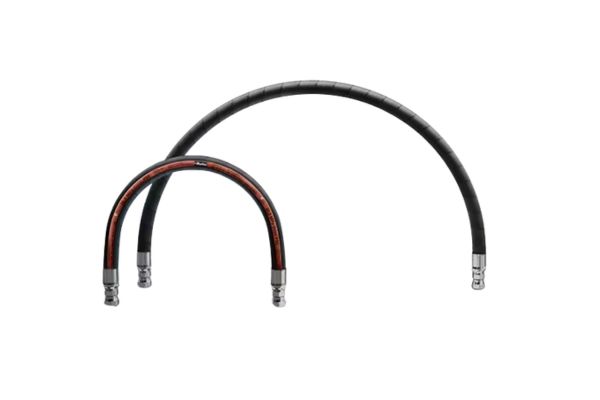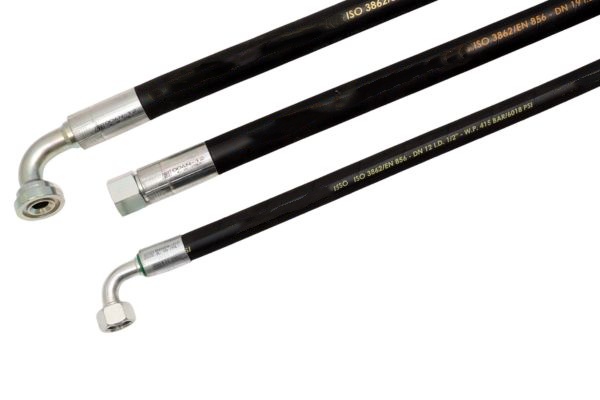You grab a new hose that fits the port perfectly, but the machine runs hot and sluggish. A simple choice has secretly sabotaged your entire hydraulic system, risking expensive, premature failure.
The correct hydraulic hose size is determined by the system’s flow rate (in GPM or LPM), not the fitting’s physical size. You must select a hose inner diameter that keeps the fluid velocity within recommended safe limits to prevent damage and ensure system efficiency.
Why is Fluid Velocity More Important Than Fitting Size?
You picked a hose that fits the port perfectly. But now your system overheats and components are wearing out prematurely. The real cause is hidden inside the hose.
Fluid velocity is the speed of oil inside the hose. If it’s too fast (hose is too small), it creates excessive heat, turbulence, and pressure loss, damaging the system. If it’s too slow (hose too big), the system response becomes sluggish.

For a detail-oriented buyer like Tony, this is the most critical concept to master. Focusing only on the fitting thread size is a common mistake that leads to expensive problems. The inner diameter (ID) of the hose is what dictates the fluid velocity, and velocity is what determines the health and efficiency of your entire system.
The Hidden Dangers of High Velocity
When a hose is too small for the given flow rate, the oil has to speed up to get through. This creates turbulent flow, which is chaotic and violent. Think of a calm, wide river (laminar flow) versus raging rapids (turbulent flow). This turbulence generates significant heat through internal friction, which breaks down the oil, cooks seals, and can lead to premature component failure. It also causes a significant pressure drop, meaning the energy from the pump is wasted as heat instead of doing useful work.
The Inefficiency of Low Velocity
Conversely, if a hose is too large for the flow rate, the fluid velocity is too slow. While this is less damaging than high velocity, it creates its own problems. The main issue is sluggish system response. The actuator (like a hydraulic cylinder) has to wait for the larger volume of oil to move, resulting in a lazy, inefficient machine. Furthermore, you’ve paid more for a larger hose and more hydraulic fluid than you needed to.
Industry-Standard Velocity Recommendations
To prevent these issues, engineers have established recommended velocity ranges for different types of hydraulic lines. Your goal is to choose a hose ID that keeps your fluid velocity within these ranges for that specific line type.
| Line Type | Recommended Velocity (feet per second) | Recommended Velocity (meters per second) |
| Suction Lines | 2 to 4 ft/s | 0.6 to 1.2 m/s |
| Return Lines | 5 to 10 ft/s | 1.5 to 3.0 m/s |
| Pressure Lines | 7 to 18 ft/s | 2.1 to 5.5 m/s |
| High-Pressure Lines | 18 to 25 ft/s | 5.5 to 7.6 m/s |
How Do You Use a Nomograph to Find the Right Hose Size?
You know velocity is key, but calculating it with formulas feels slow and complicated. There must be a simple, reliable tool to get the right answer quickly every time, right?
A hydraulic hose sizing nomograph is the tool you need. It’s a simple chart that lets you find the correct hose size with just a ruler. By connecting your known flow rate and desired velocity, the chart instantly shows you the required hose ID.

This is the exact tool my team and I use to help customers solve sizing problems. It replaces complex math with a simple, visual method, eliminating guesswork. It’s a fundamental skill for anyone who builds or maintains hydraulic systems. For a professional buyer who values precision, learning to use this chart is essential.
A Simple, Step-by-Step Guide
Using a nomograph is a three-step process:
- Find Your Flow Rate: Locate your system’s flow rate (e.g., in Gallons Per Minute – GPM, or Liters Per Minute – LPM) on the right-hand column of the chart.
- Find Your Target Velocity: Based on the table above, determine your target fluid velocity (e.g., in Feet Per Second – ft/s) for that line type. Locate this value on the left-hand column of the chart.
- Connect the Dots: Take a ruler or any straight edge and draw a line connecting your flow rate value to your target velocity value. The point where your line crosses the center column is the correct hose Inner Diameter (ID), often shown in both fractions of an inch and dash size.
What is “Dash Size”?
Dash size is a universal industry standard for naming hose and fitting sizes. The number simply represents the inner diameter of the hose in sixteenths of an inch. We use this system at Topa for all our hoses and fittings, so it’s a critical language to understand when placing an order.
- A -04 hose has an ID of 4/16″, or 1/4″.
- A -08 hose has an ID of 8/16″, or 1/2″.
- A -16 hose has an ID of 16/16″, or 1″.
The nomograph’s center column will give you this dash size directly, simplifying the entire process.
What if You Land Between Two Sizes?
This is a very common situation. Your straight line might fall between the -08 (1/2″) and the -10 (5/8″) mark. The rule is to always choose the next larger size. Sizing up will slightly decrease your fluid velocity, which is safe and efficient. Sizing down would increase your velocity beyond the recommended range, leading to heat, pressure loss, and potential damage. This is a non-negotiable rule we always advise our customers to follow for system longevity.
What Are the Real Costs of Using the Wrong Hose Size?
You’re tempted to use that smaller hose you have in stock to save time. It seems “close enough.” But could this small shortcut lead to huge, expensive system failures later?
Yes, it absolutely can. Using an undersized hose is one of the most common causes of hydraulic system failure. The initial savings are quickly erased by the high costs of downtime, component replacement, and lost productivity. Both undersizing and oversizing have significant financial consequences.
I often have to explain these trade-offs to customers who are focused solely on the initial price of the hose. They might be from a price-sensitive region like India or many parts of Africa, and they want the cheapest option. I explain that the “cheapest” hose is the one that is sized correctly because it prevents much larger future expenses. We see our role as not just a seller but a partner in our customer’s long-term success, and that means advising them on total cost of ownership, not just the upfront price tag.
The High Price of an Undersized Hose
Using a hose with an ID that is too small is the more dangerous mistake. The consequences are severe and can create a cascade of failures throughout your system.
| Consequence | The Technical Reason Why It Happens | The Business Cost |
| System Overheating | Turbulent flow creates intense friction within the oil, generating excess heat. | Damaged seals, oil degradation, reduced component life, need for larger coolers. |
| Major Pressure Drop | Energy from the pump is wasted fighting friction instead of performing work. | Reduced machine performance, higher energy consumption (fuel/electricity), lost productivity. |
| Hose & Component Damage | High-velocity fluid can erode the inner tube of the hose and damage valves & pumps. | Unexpected hose bursts, catastrophic pump failure, expensive component replacement. |
The Hidden Waste of an Oversized Hose
While less damaging, using a hose that is too large is a waste of money and efficiency. You are making a poor investment.
- Higher Initial Cost: Larger diameter hoses and fittings are more expensive.
- Increased Fluid Cost: A larger hose holds more hydraulic oil, increasing the volume and cost required to fill the system.
- Sluggish Performance: Slower fluid velocity leads to delayed response times from cylinders and motors, making the machine feel lazy and unproductive.
- Weight and Space: A larger hose is heavier and less flexible, which can be a problem in compact mobile equipment.
Conclusion
Hose sizing is not about matching ports. It’s about matching the inner diameter to the flow rate to achieve a safe fluid velocity. Using a nomograph is the professional way to ensure it. If you have questions about how to choose the right size hose, contact Topa and we’ll help you make the right choice!





